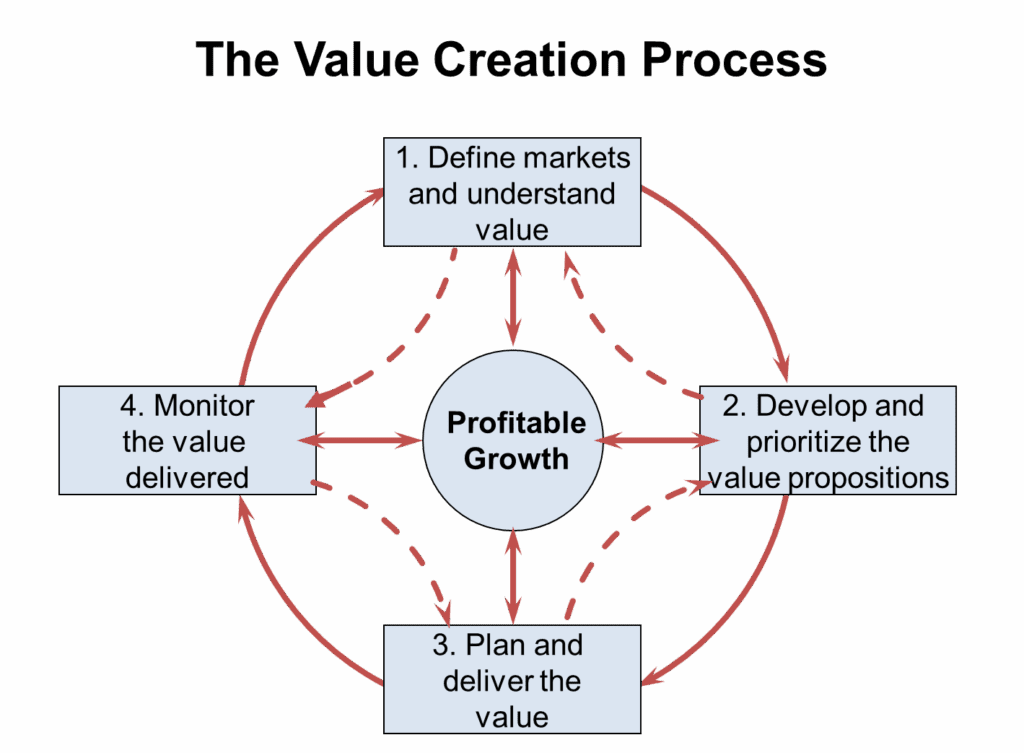Strategic Marketing
Our approach to strategic marketing
We follow a structured approach based on decades of research and practice:
- Define markets and understand value
- Develop and prioritize the value propositions
- Plan and deliver value
- Monitor the value delivered

How we help you achieve higher profitable growth with each step:
Step 1. Define markets and understand value
Mapping the market
Markets are changing rapidly. It is essential to understand how goods and services flow from the originator to the final consumer and more importantly, who the key decision-makers are. This entails defining your market and understanding what value means.
Segmenting at key decision points
Correct needs-based segmentation is the bedrock of commercial success. This is NOT socio-economics, demographics, geodemographics, or psychographics. It consists of splitting an actual market into groups of people who behave in a similar way. It is best done on the key decision points on the market map (see Mapping the market above). It is most effectively done by using the methodology spelled out in the book by Malcolm McDonald and Ian Dunbar, ‘Market Segmentation: How to do it, how to profit from it.’ (Wiley, 2012).
Understanding customer needs
The best way of understanding the needs of people in each segment is by carrying out a SWOT analysis on each. However, this is NOT the usual 4 box pointless matrix. Doing a proper SWOT analysis entails careful and detailed analysis on each segment identified from the segmentation work done above (see Proper SWOT).
Step 2: Develop & prioritize the value propositions
Prioritization of segments
Do this after Step 1: The insights about the customer from the previous step should now be turned into financially quantifiable value propositions.
The segments arising from Step 1 need to be prioritized in terms of the potential of each segment to grow the organization’s profits over the planning period (usually 3 years). We call this market segment attractiveness. To do this, they need to be placed on a vertical axis scaled from 0 to 10 and labelled ‘market segment attractiveness.’ Each market segment also needs to be placed along a horizontal axis, also scaled from 0 to 10, and according to your organization’s relative competitive strengths. You should already have quantified this from your SWOT analysis in Step 1. Place these in a four box matrix with the size of each circle being proportional to the market size (potential) of each segment.
Segmenting at key decision points
Correct needs-based segmentation is the bedrock of commercial success. This is NOT socio-economics, demographics, geodemographics, or psychographics. It consists of splitting an actual market into groups of people who behave in a similar way. It is best done on the key decision points on the market map (see Mapping the market above). It is most effectively done by using the methodology spelled out in the book by Malcolm McDonald and Ian Dunbar, ‘Market Segmentation: How to do it, how to profit from it.’ (Wiley, 2012).
The components of a value proposition
According to McKinsey, 70-80% of companies talk about value propositions but only about 5% have them. There are four components of a value proposition: functional (e.g. improving productivity), reducing cost, avoiding cost and emotional (e.g. improved trust and reliability). The first three can and should be quantified financially to demonstrate to demonstrate to the customer that the offer creates advantage as opposed to merely avoiding disadvantage.
Step 3: Plan and deliver value
Produce the strategic marketing plan
The strategic marketing plan can now be produced. For further insights visit our articles section or click here to dive into this section of process.
Implement the marketing plan
Billions of dollars are wasted from marketing plans that fail to get implemented fully. Indeed, implementing a marketing plan is one of the most perilous journeys a marketer will undertake. The risks around implementation are high and the challenges are many. To help overcome them, good marketing leaders need new knowledge, skills and tools.
Marketing Navigation by Bradford, Erickson and McDonald, draws upon recent research and years of real experience to help provide a practical guide to navigating the implementation challenges successfully.
Step 4: Monitor the value delivered
Produce the strategic marketing plan
Professor McDonald has been researching this topic at Cranfield School of Management for many years in collaboration with the Finance Faculty. The result is many papers and two books. In summary, there are three levels of marketing measurement:
- Level 1: Shareholder value added
- Level 2: Linking activities and attitudes to outcomes
- Level 3: Micro measurement
Understanding this helps to answer the following key questions:
- What needs measuring?
- Why and when?
- How frequently?
- By whom?
- Reported to whom?
- At what cost?
For further insights please see Step 4 here.